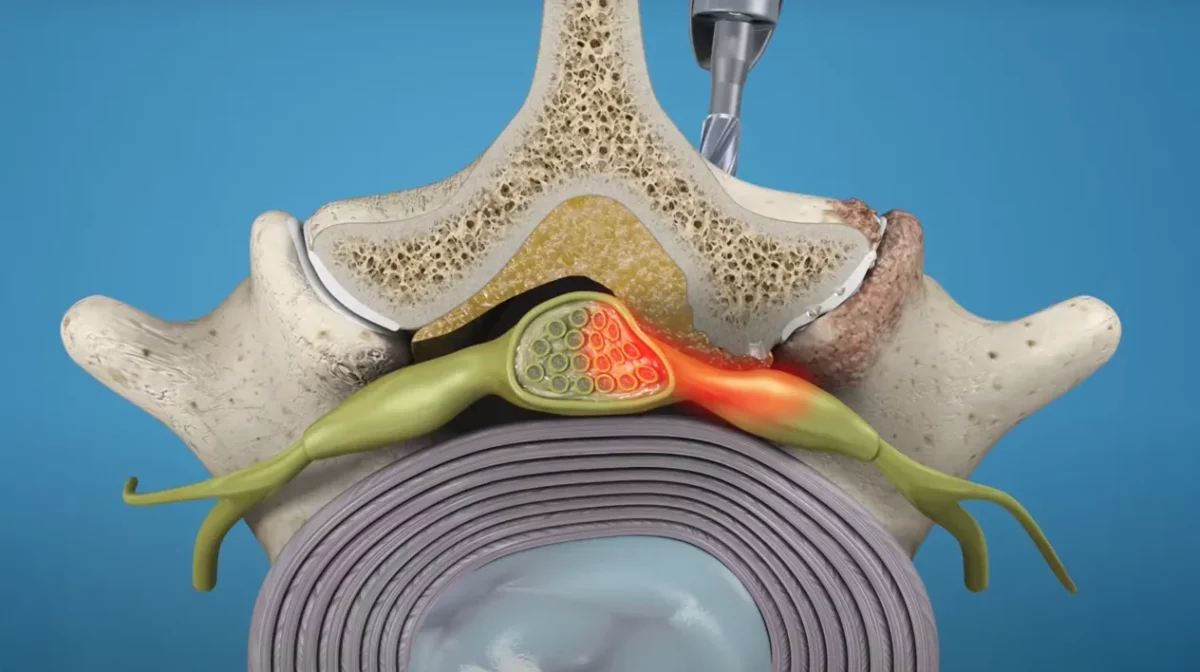Are you suffering from lower back and/or leg pain, numbness, burning, tingling, “sciatica-like” symptoms? Were you told that a fusion is your only option? While fusion is certainly the gold-standard for certain conditions, there may be a more minimally invasive option available to you, one that preserves your motion.
What Is Endoscopic Spine Surgery?
Endoscopic spine surgery involves the use of specialized instruments and a small camera (endoscope) to perform surgical procedures through tiny incisions, often less than 1cm, to relieve pressure on the nerves. Pressure, also known as stenosis, can be caused by a disc bulge or herniation, overgrowth of surrounding ligaments, or arthritis changes to the surrounding joints and bone spurs.
Endoscopic spine surgery offers several benefits compared to traditional open surgical techniques. Here are some of the key advantages:

- Minimally Invasive: Endoscopic surgery requires smaller incisions, which results in less tissue damage and reduced trauma to surrounding muscles and ligaments.
- Reduced Pain: Patients often experience less postoperative pain due to the ultra-minimally invasive nature of the procedure, which can lead to a lower requirement for narcotic pain medications.
- Shorter Recovery Time: With less tissue disruption, patients typically enjoy a quicker recovery and may return to daily activities sooner compared to traditional surgery.
- Lower Risk of Infection: Smaller incisions can decrease the risk of surgical site infections, enhancing overall patient safety.
- Less Scarring: The smaller incisions used in endoscopic procedures result in minimal scarring, often times healing with a scar smaller than a pen top.
- Improved Visualization: Endoscopic techniques often provide enhanced visualization of the spine and surrounding structures, allowing for more precise treatment of spinal conditions. The endoscope offers the ability to see the same anatomy as a larger, open procedure, through small incisions.
- Outpatient Procedure: Many endoscopic spine surgeries can be performed in an outpatient setting, allowing you to get back to the comfort of your home on the same day of surgery.
- Preservation of Muscle: With reduced disruption of the surrounding muscle tissue, there is often less postoperative muscle weakness.
- Lower Blood Loss: Endoscopic techniques generally lead to reduced blood loss during surgery as compared to larger, open techniques.
What Are Some Common Endoscopic Spine Procedures?
Endoscopic Discectomy
This procedure addresses herniated discs by removing the portion of the disc that is pressing on spinal nerves. The surgeon uses an endoscope to guide the removal of the damaged disc material. This can be performed in the Cervical, Thoracic and Lumbar spine to relieve symptoms of pressure on the nerves such as shooting pain, numbness, tingling or weakness.
Endoscopic Foraminotomy
This procedure widens the “nerve tunnels” or openings on either side of the spine where nerves exit, relieving pressure on compressed nerves. It’s especially useful for treating radiculopathy (nerve pain that radiates down an arm or leg).

Endoscopic Laminectomy
This involves removing a small section of the vertebra (lamina) and the underlying overgrown ligament to relieve pressure on the spinal cord or nerves, typically done for conditions like spinal stenosis.
Endoscopic Medial Branch Transection
This involves directly visualizing, and then trimming and “burning” the edges of the branch of the nerves that travels to the facet joints in your back. This is the nerve that leads to a lot of the “arthritis” back pain that you may be experiencing. This may be a more long-lasting solution as compared to traditional radiofrequency ablation (RFA), often referred to as “burning of the nerves.”
Who Is a Candidate for Endoscopic Spine Surgery?
Endoscopic spine surgery is indicated for various spinal conditions, including:
- Herniated Discs: When a disc bulges or ruptures and presses on nerve roots.
- Spinal Stenosis: Narrowing of the spinal canal, leading to nerve compression.
- Degenerative Disc Disease: Age-related changes that cause pain and discomfort.
- Spondylolisthesis: A condition where one vertebra slips over another.
While endoscopic spine surgery has many benefits, it is not suitable for everyone. Open communication with an Endoscopic Spine Surgeon is crucial for determining the best treatment plan based on individual needs. There is no one-size fit all solution for spine care, and it is crucial to explore all options to best treat your pain.
If you are experiencing significant leg and back pain, schedule a consultation with Dr. Nathaniel Rawicki, at our Hammond or Covington office, to see if endoscopic spine surgery is right for you!


